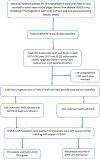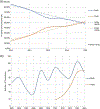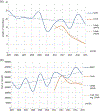Contemporary trends and outcomes in aortic valve replacement in patients with end-stage liver disease
- PMID: 32129573
- PMCID: PMC7484033
- DOI: 10.1002/ccd.28834
Contemporary trends and outcomes in aortic valve replacement in patients with end-stage liver disease
Abstract
Objective: Even in high-risk trials pertaining to transcatheter aortic valve replacement (TAVR), patients with end-stage liver disease (ESLD) have been under-represented. We sought to study this population group from a large national United States population database.
Methods: We used National Inpatient Sample (NIS) database from January 2005 to August 2015. Patients with ESLD were extracted using Goldberg's algorithm. Propensity match analysis was done for comparative analysis between surgical aortic valve replacement (SAVR) and TAVR groups. Logistic regression analysis was used for predictors of in-hospital mortality.
Results: Out of 309,959 ESLD patients, 1,375 underwent aortic valve replacement and 1,199 patients were included in our study. Mean age was 66.1 (SD, 9.1) years. In matched data, the in-hospital mortality was 5.5% in TAVR group when compared to 19.4% in SAVR group. Ventilator use (16.1 vs. 27.2%, p < .01), tracheostomy (<4 vs. 7.2%, p < .01), and vasopressin use (0 vs. 7.4%, p < .01) were utilized less in TAVR group as compared to SAVR group. The proportion of TAVR has increased from almost zero in 2011 to 51.3% in 2015. Mean cost for hospital stay has increased in SAVR group (from 254,427$ in 2005 to 321,791$ in 2015, p < .01). Similarly, a large decrease in length of stay has been observed for TAVR group (14.5 days in 2011 to 5.4 days in 2015, p < .01). TAVR (odds ratios [OR]: 0.42, 95% confidence interval [CI]: 0.20-0.87, p = .02) was associated with lower in-hospital mortality.
Conclusion: TAVR was associated with lower in-hospital mortality, morbidity, and resource utilization in high-risk ESLD patients.
Keywords: end-stage liver disease; outcomes; surgical aortic valve replacement; transcatheter aortic valve replacement.
© 2020 Wiley Periodicals, Inc.
Conflict of interest statement
CONFLICT OF INTERESTS
The authors declare no conflicts of interest.
Figures





Comment in
-
TAVR versus SAVR in patients with severe aortic stenosis and concomitant end stage liver disease: When less is more.Catheter Cardiovasc Interv. 2020 Oct 1;96(4):956-957. doi: 10.1002/ccd.29291. Catheter Cardiovasc Interv. 2020. PMID: 33085198 No abstract available.
Similar articles
-
Transcatheter versus surgical aortic valve replacement in patients with end stage renal disease.Catheter Cardiovasc Interv. 2020 Nov;96(5):1102-1109. doi: 10.1002/ccd.29109. Epub 2020 Jul 7. Catheter Cardiovasc Interv. 2020. PMID: 33034959
-
In-hospital outcomes of transcatheter versus surgical aortic valve replacement in non-teaching hospitals.Catheter Cardiovasc Interv. 2019 Apr 1;93(5):954-962. doi: 10.1002/ccd.27968. Epub 2018 Nov 8. Catheter Cardiovasc Interv. 2019. PMID: 30408309
-
Temporal Trends and Outcomes of Transcatheter Versus Surgical Aortic Valve Replacement for Bicuspid Aortic Valve Stenosis.JACC Cardiovasc Interv. 2019 Sep 23;12(18):1811-1822. doi: 10.1016/j.jcin.2019.06.037. JACC Cardiovasc Interv. 2019. PMID: 31537280
-
Transcatheter aortic valve replacement versus surgical aortic valve replacement in low-surgical-risk patients: An updated meta-analysis.Catheter Cardiovasc Interv. 2020 Jul;96(1):169-178. doi: 10.1002/ccd.28520. Epub 2019 Oct 21. Catheter Cardiovasc Interv. 2020. PMID: 31631514
-
Efficacy and safety of transcatheter aortic valve replacement in aortic stenosis patients at low to moderate surgical risk: a comprehensive meta-analysis.BMC Cardiovasc Disord. 2017 Aug 24;17(1):234. doi: 10.1186/s12872-017-0668-1. BMC Cardiovasc Disord. 2017. PMID: 28836953 Free PMC article. Review.
Cited by
-
Cardiology Assessment of Patients Undergoing Evaluation for Orthotopic Liver Transplantation.J Soc Cardiovasc Angiogr Interv. 2022 Nov 25;2(1):100528. doi: 10.1016/j.jscai.2022.100528. eCollection 2023 Jan-Feb. J Soc Cardiovasc Angiogr Interv. 2022. PMID: 39132526 Free PMC article. Review.
-
Outcomes of transcatheter vs surgical aortic valve replacement in pre-existing chronic liver disease patients: A meta-analysis of observational studies.Int J Cardiol Heart Vasc. 2025 Mar 28;58:101651. doi: 10.1016/j.ijcha.2025.101651. eCollection 2025 Jun. Int J Cardiol Heart Vasc. 2025. PMID: 40230501 Free PMC article. Review.
-
Clinical outcomes of patients with hepatic insufficiency undergoing transcatheter aortic valve implantation: a systematic review and meta-analysis.BMC Cardiovasc Disord. 2022 Feb 23;22(1):67. doi: 10.1186/s12872-022-02510-2. BMC Cardiovasc Disord. 2022. PMID: 35196988 Free PMC article.
-
Prognostic value of the dynamic hepatorenal function on intermediate-term mortality in TAVI patients with survival to discharge.Clin Cardiol. 2023 Jan;46(1):84-91. doi: 10.1002/clc.23940. Epub 2022 Nov 30. Clin Cardiol. 2023. PMID: 36448412 Free PMC article.
-
In-Hospital Outcomes and 30-Day Readmission Rate After Transcatheter and Surgical Aortic Valve Replacement in Liver Cirrhosis: A Contemporary Propensity-Matched Analysis.Struct Heart. 2024 Jun 12;8(6):100327. doi: 10.1016/j.shj.2024.100327. eCollection 2024 Nov. Struct Heart. 2024. PMID: 39670045 Free PMC article.
References
-
- Dhoble A, Bhise V, Nevah MI, et al. Outcomes and readmissions after transcatheter and surgical aortic valve replacement in patients with cirrhosis: a propensity matched analysis. Catheter Cardiovasc Interv. 2018;91:90–96. - PubMed

